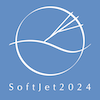Conveners
Session 3: Session 3
- Xin-Nian Wang (Lawrence Berkeley National Lab. (US))
We begin by using Hybrid Model calculations to reproduce experimental results published by ATLAS in 2023 on $R_{AA}$ for $R=1$ jets in Pb+Pb collisions. These jets are identified via first reconstructing anti-$k_t$ $R=0.2$ subjets and then reclustering them. Following ATLAS, we investigate how $R_{AA}$ for these large-radius jets depends on the angle between the two subjets involved in the...
Due to the strongly coupled nature of quark-gluon plasma (QGP) formed in heavy-ion collisions, and the notorious difficulties in carrying out QCD calculations at realistic values of the coupling, supersymmetric N=4 Yang-Mills theory at large N_c has served as a highly helpful reference point to gain intuition on aspects of the strongly coupled physics of QGP.
In this work, we revisit the...
Heavy-ion collisions have been used to study quark-gluon plasma (QGP)
and can be used to study strong electromagnetic (EM) fields. Because the
EM fields penetrate the QGP medium, their evolutions are coupled
together. In turn, both contribute to the production of photons [1, 2].
Usually, the EM field modifications are considered separately from the
evolution of the QGP. Instead, we model...
